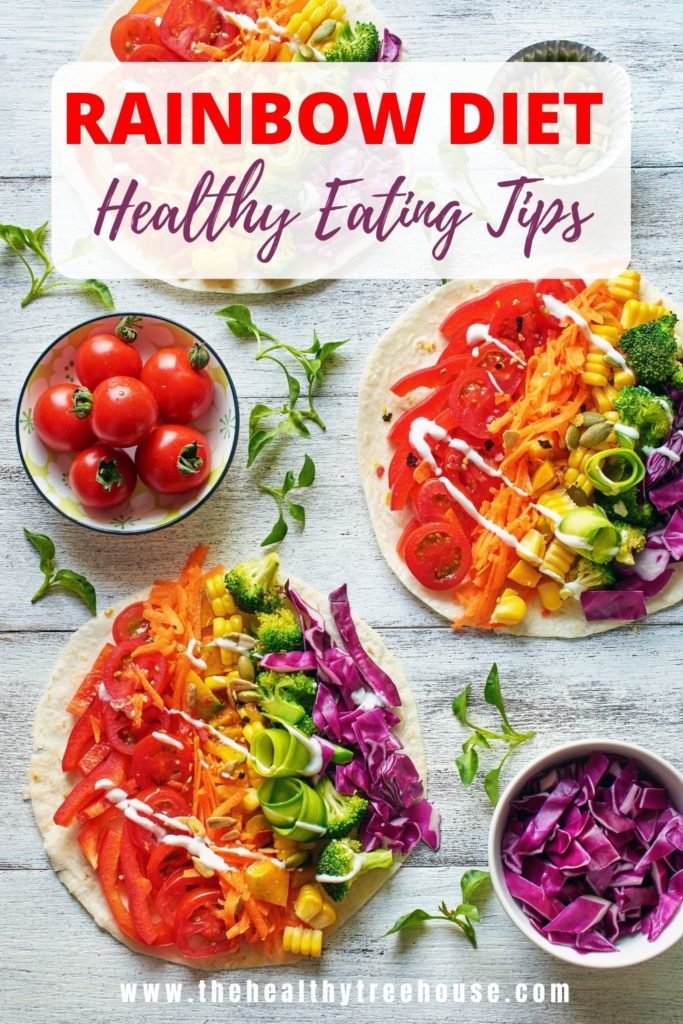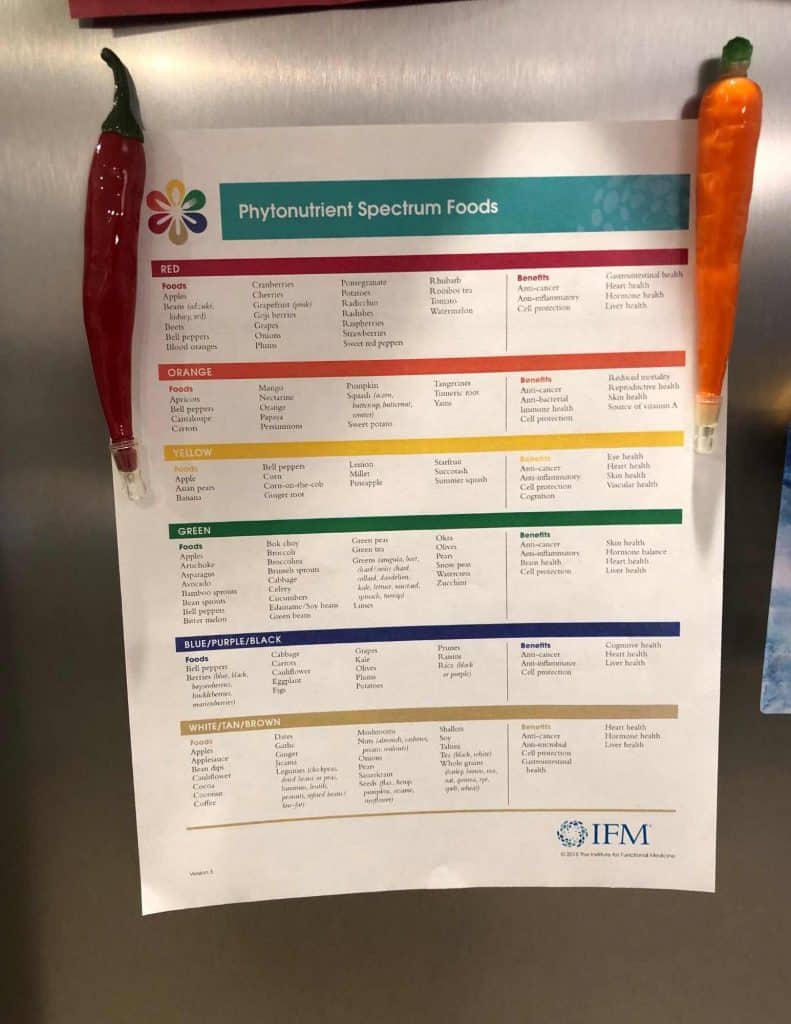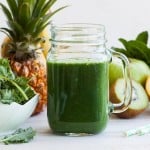
If you’ve got kids, you’ll understand when I say that one of the biggest challenges is making sure they’re eating healthy foods every day.
My daughter would eat chocolate for breakfast, lunch, and dinner if she could!
Truthfully, though, eating healthy is not just for kids.
It’s for all of us.
I know this from first-hand experience.
I battled food allergies, digestive issues, and what seemed like a never-ending cold for years.
I had more than my fair share of medical emergencies, but my life changed when I changed my diet.
Below, we’ve narrowed down this list of super-healthy (and surprisingly tasty) suggestions to the Top 10 foods you can keep in your fridge or cupboard and incorporate into your diet every day.
What Are the Healthiest Foods?
A balanced meal requires a good mix of different foods. Let’s look at the wide variety you can eat on a healthy diet.

Eat the Rainbow
If you’re unsure how to pick the healthiest options, you can’t go wrong by eating the rainbow. Not the skittles variety—we’re talking about the full spectrum of fruits and vegetables.
Summarizing Harvard Medical’s opinion, the different colors mean they are loaded with a variety of antioxidant-rich components, which are also responsible for their varying colors.
We need all of these ingredients in our diet, so including a colorful platter of fresh produce in your regular meals will help you attain better health status.
The American Cancer Society and the US Dietary Guidelines recommend eating at least 2 1/2 cups per day of fruits and vegetables, based on a 2,000-calorie diet.
We keep this [printable] PDF hanging on our fridge door.
We like its simplicity. It’s a great reminder to eat the rainbow every day.
And, it’s something we have recently started to teach our young daughter, which has helped her learn and develop healthy eating habits in the early years of her life.

Most people’s diet consists mainly of processed foods, comprised of different shades of brown.
Think of the typical breakfast menu – waffles, pancakes, ready-to-eat cereal, and sausage.
It does not need to be this way.
Instead, for example, you could have a fruit smoothie with blueberries, peaches, and raspberries, which would give you three colors of the rainbow.
Note that this does not mean you should avoid eating meat.
It simply means you should also eat fruits and vegetables that consist of at least two different colors each day.
Kathy Hoy, EdD, RD, nutrition research manager for the PBH, says “Nutrients and phytochemicals appear to work synergistically, so maintaining a varied, colorful diet with healthful whole foods is a pragmatic approach to optimal nutrition.”
Summary: Multiple reputable sources confirm that eating a wide variety of colors in your diet will provide optimal health benefits, not excluding meat.
Colors of the Rainbow
Here is a list of colors for your fresh produce that you should look forward to buying on your next trip to the grocery store.
RED
Tomatoes are known to prevent prostate cancer, while strawberries are great for heart health. Raspberries, cherries, and apples all have anti-cancer and anti-inflammatory properties.
PURPLE /BLUE
Blueberries, Concord grapes, figs, and eggplants all contain anthocyanins, which offer powerful antioxidant benefits. This category of foods also help to delay cellular aging and help the heart by blocking the formation of blood clots.
ORANGE/YELLOW
Carrots, pumpkin, yellow peppers, and oranges all belong to this category. The plant pigments carotenoids is responsible for giving these ingredients orange/yellow hues. This group of produce will also be rich in vitamin A, which is an important vitamin that also offers antioxidant and anti-inflammatory benefits.
GREEN
Including spinach, avocados, asparagus, broccoli, kale, kiwi fruit, green tea, and green herbs (mint, rosemary, thyme, and basil), this group of fruits and vegetables get its green hue from the presence of chlorophylls. Green leafy vegetables and herbs (such as spinach, kale, mint, basil, etc.), kiwifruit, asparagus, broccoli are some of the ingredients that are rich in cancer-blocking chemicals, which inhibit the action of cancer-causing carcinogens.
BROWN/WHITE
Onions, cauliflower, garlic, and mushrooms all contain antioxidant flavonoids like quercetin and kaempferol. Quercetin reduces blood pressure, inflammation, and blood glucose levels. Both quercetin and kaempferol act as antioxidants and prevent inflammation and cancer.
Summary: All foods from all colors of the rainbow have their own unique health benefits contributing to your overall wellness.
Snacking Foods
Snacks are an essential part of life!
This is where I tend to go wrong with my eating.
We cook wonderfully healthy meals, then I snack on all the worst stuff in between.
But, recently I have found some great snacking options that are really easy to prepare and are extremely healthy too.
Here are a few examples of the healthy snack food options:

Here are some options that you can’t go wrong snacking on:
Fruit
Yep! This healthy stuff can make great snacking.
Fruits are packed with vitamins and nutrients and also add a nice dash of fiber, which we can all do with.
Apples (Red)
Vitamin C and fiber are abundant in apples, and this tasty fruit comes in many varieties and colors. What’s not to love?
One of the best things about apples is that they are as effective as a cup of coffee at waking you up on those long days.
Apples are also supremely affordable, so if your kids like to eat between meals, keep some of these laying around.
Citrus Fruits (Orange)
These fruits are the kings of Vitamin C.
They taste great and keep the flu away, which is awesome.
Oranges and grapefruits are the most common here.
For some reason, nobody wants to chew on a lemon, despite their amazing health benefits.
Berries (Reds or Blues)
Kids love berries. Maybe it’s the mess they make.
Berries are high in antioxidants, blueberries in particular.
Of course, they’re also super tasty, low calorie, low in fat, and high in vitamins and flavor.
Frozen berries mixed into a smoothie are amazing summertime snacks.
Bananas (Yellow)
Bananas are one of the best ways to get your daily dose of potassium.
If you need extra fiber in your diet, you’ll do well to add a snack banana to your daily intake.
They contain high levels of vitamin B6 that is an excellent energy booster if you’re feeling a little sluggish.

Nuts, Seeds, & Legumes (Browns)
If you don’t like fruit that much, that’s okay.
Try some nuts, seeds, or legumes instead.
They’re higher in calories but are a fantastic source of healthy fats, vitamins, and minerals.
Easy-to-find nuts include almonds, macadamias and walnuts.
It may surprise you to find that peanuts are not nuts at all, but legumes.
They’re still healthy and a tasty snack, though.
Pumpkin seeds, sunflower seeds, and sesame seeds are among the most familiar seeds.
If you’re looking for something a bit different though, try some chia seeds.
They’re one of the most nutrient-dense foods out there, packing 11 grams of fiber per 28-gram serving!
Legumes include peas, chickpeas, kidney beans, and the aforementioned peanuts.
Basically, if it grows in a pod, it’s a legume.
They make awesome snacks when they’re dried and spiced.
Raw Veggies
If you prefer something with less sweetness, you can always chew on a raw veggie.
Raw vegetables are packed with even more nutrients than cooked ones, with the exception of raw tomatoes.
Cooked tomatoes are a better source of lycopene, which is a vital component to prevent prostate cancer.
Try raw broccoli, green beans, or snow peas for a Vitamin C boost.
Raw green peppers or onions pack a punch in terms of rich antioxidant content.
There are some veggies that shouldn’t be eaten raw, though.
Cassava contains poison and needs to be cooked to remove any trace of it before eating.
Eggplant, being a member of the poisonous nightshade family, can present problems if eaten raw.
Kidney beans also need to be cooked to remove a particular toxin.
If your kid gets into your veggie stash and chomp on too much raw stuff that they shouldn’t, get some medical advice just to be safe.
Eggs
Eggs are pretty underrated, especially if you’re a parent.
Did you know you can prepare them in more than ten different ways?
As parents, we approve of eggs because they’re one of the most versatile foods you can find.
They used to get a bad rap, but since studies have shown that they aren’t as high in cholesterol as everyone thought, they’ve made a comeback as a bit of a superfood.
Yogurt
Yogurt contains a ton of probiotic bacteria.
That may sound awful to some, but believe us, it’s a good thing.
Your immune system will enjoy the boost, and yogurt fortifies against the nasty bacteria varieties that come knocking.
Try and find one with as little added sugar as possible, though.
If you or the kids are on antibiotics, a daily portion of yogurt is extremely helpful.
Antibiotics kill off good bacteria as well as bad, so having yogurt on hand to replenish those good bacteria is a good idea.
Dark Chocolate
Chocolate lovers, you don’t have to give up your favorite treat.
You just need to eat the variety that’s antioxidant-rich and offers far more health benefits than the sugary stuff.
Similar to veggies, dark chocolate contains phytonutrients, or plant chemicals, that can help lower the risk of heart disease, strokes, and diabetes.
We definitely recommend working a bit of 70 or higher percent dark chocolate into your diet!
Summary: There is a myriad of healthy snacking food that includes more than just eating plain raw fruits and veggies, suitable for all diet preferences.
Meal Foods
While all of the snack foods can also be served as part of a meal and vice versa, these are more commonly associated with your larger meals.
Here is an example of a healthy meal recipe:

Vegetables
Veggies are usually low in protein but high in fiber and filled to the brim with nutrients.
These are our favorite vegetables that we include with our meals.
Asparagus (Green)
This weird-looking green vegetable is a good source of Vitamin K.
It’s super low in calories, fat, cholesterol, and sodium.
You can also cook asparagus in about any way you can think of.
It’s surprisingly high in protein for a small green stick, with 2.2 grams per 100 grams.
It’s tasty too.
If you enjoy crunching on a piece of raw asparagus as a snack, that’s totally okay too.
Broccoli & Cauliflower (Green & Brown/White)
These two are known as cruciferous vegetables that sound vaguely like something from the dinosaur-age.
They’re fantastically healthy, though, and complement each other wonderfully in a salad, roasted, or a broccoli and cauliflower bake.
Broccoli is higher in vitamins, but they’re both nutritious, delicious, and high-volume, meaning that you can fill up by eating just a moderate amount.
Carrots (Orange)
Ah, the carrot. The perfect vegetable.
It’s crunchy, yummy, and contains a ton of vitamins, minerals, and antioxidants.
You can eat it raw or cooked.
They put hair on your chest and help you see in the dark.
The main stuff you’ll find in a carrot is beta carotene that converts to Vitamin A in the body.
It’s great for eye and skin health and building up the immune system.
You’ll also get a good dose of Vitamin K, potassium, and fiber in each crunchy bite.
Garlic (White)
We get it — nobody wants to go through every day with garlic breath.
It’s a potent vampire repellent, though — just kidding!
People have used garlic for centuries to boost the immune system and fight off colds and flu.
It may have a strong smell and taste, but that comes with fantastic anti-inflammatory and anti-bacterial properties, and it also helps to regulate blood pressure.
Another nice little bonus is that cooking with garlic can help kill the bacteria that cause food poisoning.
Cooking also reduces the pungent smell and taste, so it’s something you should add to your dishes every day!
Peppers & Onions (Red/Yellow/Green/White)
Bell peppers are loaded with Vitamin A, Vitamin C, and potassium.
Their traffic-light colors make them fun for kids, so you can get creative if your kid doesn’t naturally enjoy veggies!
People often look at onions with the same disdain as garlic, but they have surprisingly similar health benefits.
They’re filled with antioxidants, which give them their distinct flavor and tart aroma.
Sulfur levels are also high in onions, which supplies the body with essential amino acids.
If you like them raw, well, you’re brave.
If not, throw a sliced onion in when cooking, and you’ll notice a difference in both flavor and your immune system!
Sweet Potatoes (Orange)
Sweet potatoes are not only healthy, they’re also easy to make kid-friendly stuff with.
Sweet potato burger buns or patties, sweet potato puffs, crisps, and mash are just a few of the fun (and healthy) things you can make with sweet potatoes!
They’re slightly higher in (natural) sugar than white potatoes, but they are lower in carbs and calories.
White potatoes have more fiber, but the sweet ones have higher levels of Vitamin A and Vitamin C.
Meat
Protein is an essential nutrient that we need to maintain our health.
It contains fatty acids and amino acids that are the building blocks of the body and help build muscle and keep cells strong.
The phytonutrient food spectrum is for fruits and vegetables only, so meats do not get assigned a rainbow color.
These are our favorite meats:
Lean Beef or Bison
Beef is a good source of protein and nutrients.
In fact, it’s probably one of the best proteins you can choose.
You can go for something lean or a piece with more fat, if you don’t mind it.
Beef is filled with iron, which is one of those essential things to keep you living a healthy life.
It’s also super nutrient dense, so it will keep you fuller for longer!
We prefer bison for spaghetti and hamburgers, but lean beef for tacos.
For the most part, though, these two meats are interchangeable.
Typically, we mix our beef with other foods; it’s healthier.
We do occasionally have a steak.
When we do have steak, then we allow ourselves to enjoy the best grass-fed organic option available.
Ground Turkey
Surprisingly, the nutritional differences between ground turkey and lean beef or bison are minimal.
However, the ground turkey industry has struggled with salmonella for years, including more recently.
In my opinion, when it is mixed with other food, it tastes just like beef, so I am not sure there is any reason to take the risk.
Accordingly, we recommend eating lean beef or bison instead of ground turkey.
That said, whole turkey or sliced turkey that is properly prepared and cooked to 165 degrees is wonderfully lean and very flavorful meat.
So, we do eat turkey at our holiday meals and in our sandwiches, especially when we know it has been prepared properly.
Chicken
Chicken is the most protein-rich meat out there, is low in fat, and is very calorie friendly.
It’s versatile too – roast it, grill it, or coat it in breadcrumbs and fry it in some olive oil.
We eat more chicken by far than any other meat.
Chicken strips are a crowd pleaser in our house.
Fish
Whatever fish you choose to cook, it likely has high levels of Omega-3 fatty acids.
This makes it one of the healthiest foods around.
We don’t eat enough of it.
Surprisingly, our daughter loves salmon.
Fish also contain iodine, which is one of the widespread deficiencies that people don’t realize they have.
Studies have shown that a diet high in fish can help prevent cardiovascular disease and keep our brains sharp as we age.
Some kid-friendly options are baked salmon and zoodles and potato chip fish filets.
Whole Grains
More than 40 percent of people don’t eat any whole grain foods!
It’s hard to figure out what exactly is whole grain, though.
Basically, the whole grain contains every edible part of the grain.
It has nothing removed, making it well rounded and nutritious.
Things like brown rice, wild rice, quinoa, millet, bulgur wheat, and whole oats or oatmeal are the more common whole grains.
Oh, and popcorn. You can never have enough popcorn in the house.
Cooking Oils
Healthy fats are another crucial part of our daily diets.
Cooking oils can be a good source of them, or they can be seriously unhealthy.
We recommend these cooking oils:
Extra Virgin Olive Oil
Extra virgin olive oil is one of the healthiest cooking oils you’ll find.
It’s an antioxidant superhero, contains plenty of healthy fatty acids, and has a nice dose of Vitamin E and Vitamin K, too.
Contrary to what one might think, it actually reduces the chances of heart disease.
Extra virgin olive oil soothes inflammation and may help lower bad cholesterol, both of which play significant roles in cardiovascular problems.
This oil is rich in monounsaturated fat that goes by the name of oleic acid, comprising 73% of its total oil content.
Besides this, 11% of it is made of omega-6 and omega-3 fatty acids.
It’s higher in Omega-6 than Omega-3 fatty acids, but we need the 6s too!
Spices
Spices add flavor and a little dash of anti-inflammatory properties to your meals.
Some great spices to add to your cooking are turmeric, ginger, garlic, or cinnamon when you want some sweetness.
They add virtually no calories to dishes, just a ton of flavor and healthiness!
Summary: Foods that comprise a whole meal such as veggies, meats, oils, whole grains, and spices all add unique health benefits that can be mixed and matched based on your taste buds and nutrition needs.

The 10 Best Superfoods to Eat
Eating healthy is easier now than at any point in human history.
We now have more options than ever before.
So, which ones should you make sure you eat as often as possible?
Research shows that healthy dietary patterns can reduce the risk of high blood pressure, heart disease, diabetes, and certain cancers.
Mostly plant-based diets, like the Mediterranean Diet, have demonstrated significant health benefits, including the reduction of chronic disease.
If we had Oscar Awards for foods, then the top 10 nominees for superfoods would be:
- Berries (When not in season, it’s just as healthy to buy them frozen)
- Fish (fresh, frozen, or canned, such as salmon, tuna steaks, trout, sardines, etc.)
- Leafy greens (spinach, kale, etc.)
- Nuts (almonds, hazelnuts, pecans, walnuts)
- Olive oil
- Whole grains (brown rice, oatmeal, quinoa, etc.)
- Yogurt
- Cruciferous vegetables (broccoli, cabbage, cauliflower, etc.)
- Legumes (kidney, black, red, soybeans, peas, etc.)
- Tomatoes
What Food Should I Eat Every Day?
Although you need not eat each one of these every single day, it’s a good idea to make sure you get in a protein, some vegetables, a whole grain, and a healthy snack daily.
You are free to mix and match what meats and veggies you eat together and what snacks you choose on which days.
While doing this, just ensure you’re getting fiber, protein, carbs, and healthy fats in every meal you eat.
It’s easy to get this right with a bit of forward planning!
Summary: Superfoods are an essential part of everyone’s diet that has so many benefits to incorporating them into your diet, as well as protein, vegetables, whole grains, fiber, and healthy fats daily.
Tips & Tools to Help You Choose Great Healthy Snacks
Happy Forks
Happy Forks is a great tool.
Type in any food, and you’ll be able to find all the nutritional info you might need.
A feature we particularly like is their Recipe Analyzer.
Just copy and paste your recipe, and it will work out the calories and nutrients for you!
Even if you don’t count calories as part of a diet, it’s helpful to know if you’re overdoing it on any particular nutrient.
It is called a balanced diet, after all.
What Foods Help Burn Belly Fat?
This one is more for the parents than the kids.
Belly fat can not only be uncomfortable, but it can lead to other health issues.
Although there is no magic food that melts away belly fat, research has shown that decreasing your sugar intake and choosing certain foods over others can help.
Five superfoods that help you lose weight:
- Almonds – rich in healthy fats, minerals, antioxidants, and fiber, which improves your overall health status
- Tomatoes – low-calorie and reduces water retention
- Avocado – high in healthy fats and fiber, helping you feel satiated
- Apples – rich in dietary fibers, which helps you feel satiated
- Tart cherries – lower cholesterol levels and help you burn fat
Mediterranean-style dishes, rich in healthy fatty acids, are cited as the best way to go to reduce belly fat, and while we can’t give it a total thumbs up for lack of evidence, the benefits of healthy fats are widely accepted.
Choose fish over other meats whenever possible, cook with an acceptable amount of olive oil, and eat snacks like nuts and seeds to help burn belly fat.
And, of course, eat your meals in a controlled portion while pairing all of this with regular exercise!
If you want to lose weight faster, then you might enjoy our Keto Diet For Beginners until you reach your weight goal.
Summary: There are tons of tools to help you choose healthy snacks, and also superfoods that can help you burn belly fat while maintaining portion control and regular exercise.
Recommended Products To Try
What you make in the kitchen may impact your health more than anything else.
The correct kitchen gear can make the process of cooking much easier.
Eating the rainbow is more fun when you use rainbow-colored knives to prepare your food!
We love this Cuisinart 12-piece Ceramic Knife Set.
When used correctly, they can stay sharper and last longer than metal ones.
You can read our full review about them here.
Smoothies are a great way to eat fruits and vegetables, especially berries.
A good blender can help.
Blenders make healthy eating convenient for us, as you simply have to add all the colorful ingredients into the blender pitcher and blend it all together.
Luckily, we have a full review of the best blenders for smoothie making.
Our top-rated best blender for this was the NutriBullet Magic Bullet (NBR-1201).

Summary
Eating healthy food every day shouldn’t be a chore!
As long as you’re planning meals sensibly and sticking to non-processed snacks as much as possible, you’ll be good to go.
I believe it is very important that we teach young children about how eating food affects their health.
Children should be made familiar with various ingredients, to which food group it belongs to, and what is the primary reason for us to eat it.
Kids will then eat their healthy stuff with no complaints with the notion of knowing an “unhealthy” treat or dessert is coming later!
As long as you’re getting quality protein, healthy fat, and a decent amount of fiber, your body will react well to the nutrients, and you’ll notice an improvement in your health.
What healthy food or snacks do you keep in your kitchen? Let us know in the comments!


